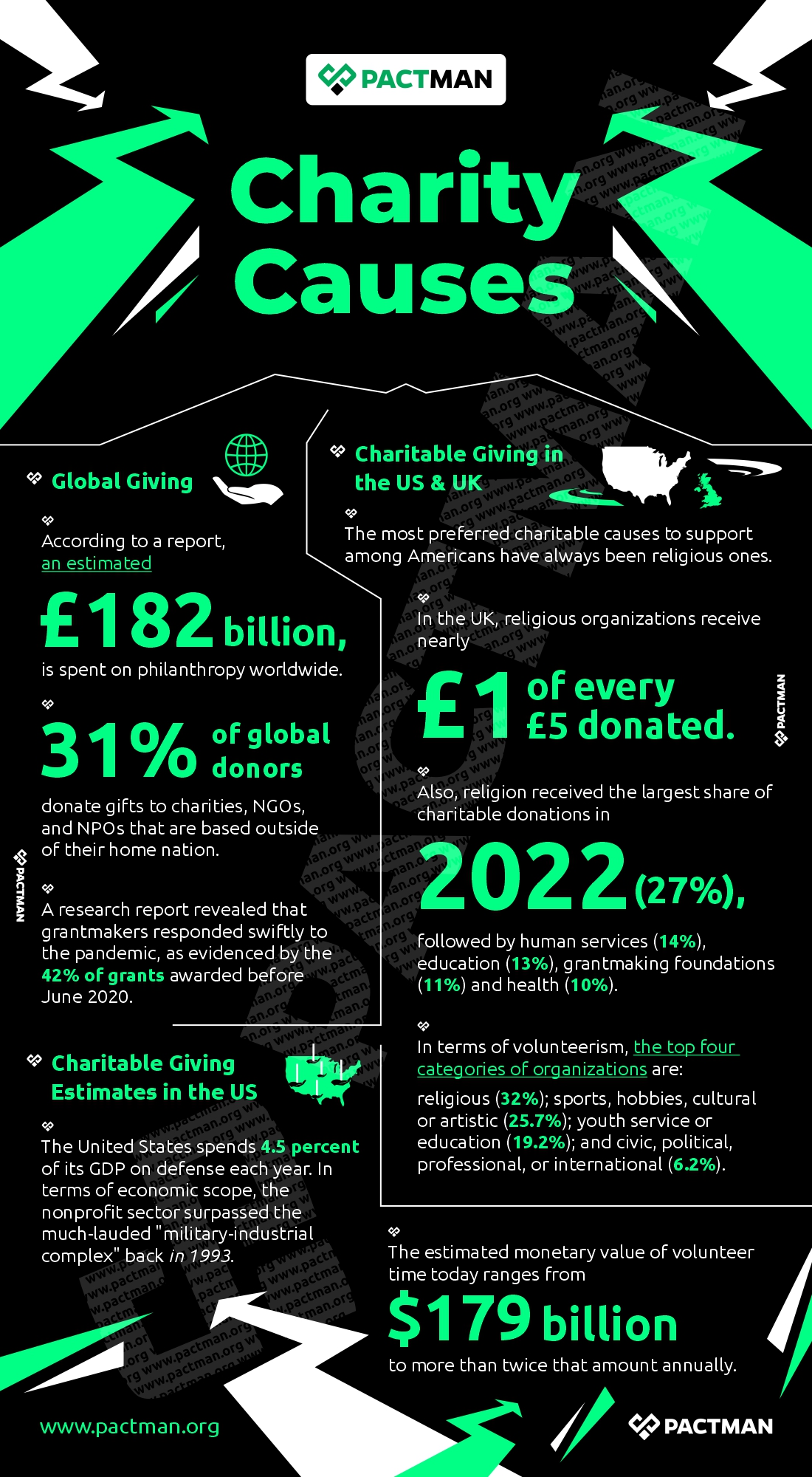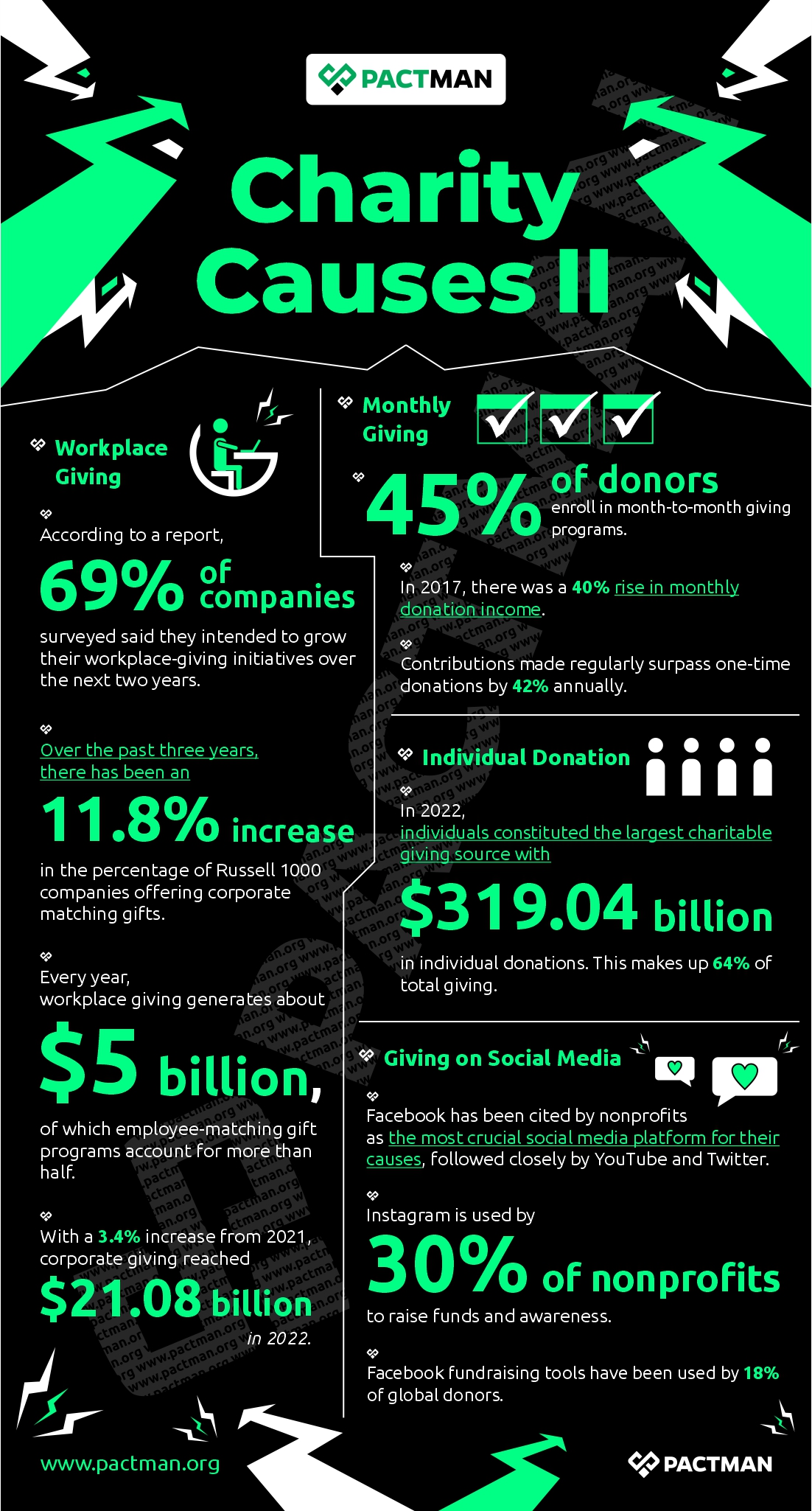I
Introduction
Choosing which charity causes to support can often pose a complex challenge with significant ramifications for donors, recipients, nonrecipients, and society as a whole. Also, the abundance of ‘giving opportunities’ can create a difficulty in choice for those who want to use their wealth to support organizations that promote the public good.

As we all know, the issues we hear about the most aren’t always the ones that have the most impact. While we believe that donors should give based on their values and worldviews, it has been discovered that some problems are both larger and easier to solve than others. Likewise, some issues receive more funding than others based on their urgency.
We believe that the cause(s) you choose to support should reflect your worldview and values. However, there are several other factors to keep in mind. Hence, in this article, we will consider effective ways to choose the right charity causes to support.
II
What Motivates Giving to Charity Causes?
Early in the 1990s, there was a significant study of public opinion in the UK regarding charities and volunteering. The study’s conclusion revealed that the definitions of what constitutes a charity and the “right” recipients of charity causes are inherently subjective.

By and large, the study showed that “neediness” was found to be a distinguishing characteristic such as people who are in need through no fault of their own. This includes the ill, children, and victims of disasters as these issues are viewed as the most deserving of charitable support.
However, several studies have shown that only a small portion of charitable benefits go to the poor and needy. This defies popular belief that giving to charity is the way for needs to be met through the transfer of resources from the well-off to the underprivileged.
Prior research carried out in the UK indicates that there is a widespread public consensus that a charitable concern demands that the recipient be in need. This is despite historical precedents and the absence of any objective justification for such expectations. Even more, some donors questioned if certain organizations qualified as charities because they failed to satisfy those needs.
To begin with, donor choices of what to support have been largely influenced by social networks and social norms rather than just evidence of need. Furthermore, it is crucial to remember that charities are not required by most legal frameworks to provide for the needs of any specific group or to redistribute money. Rather, their legal definition refers to the promotion of public benefit.
III
Critical Statistics on Giving to Charitable Causes
In this section, we will consider statistical reports on various charitable giving globally and within specific countries.
a. Global giving
According to a report, 31% of global donors donate gifts to charities, NGOs, and NPOs that are based outside of their home nation. A research report revealed that grantmakers responded swiftly to the pandemic, as evidenced by the 42% of grants awarded before June 2020.

b.Charitable Giving in the US & UK
The most preferred charitable causes to support among Americans have always been religious ones. Likewise, in the UK, religious organizations receive nearly £1 of every £5 donated.
Also, religion received the largest share of charitable donations in 2022 (27%), followed by human services (14%), education (13%), grantmaking foundations (11%) and health (10%).
In terms of volunteerism, the top four categories of organizations are: religious (32%); sports, hobbies, cultural or artistic (25.7%); youth service or education (19.2%); and civic, political, professional, or international (6.2%).
c. Charitable Giving Estimates in the US
The percentage of charitable activity in the US economy is steadily increasing. For context, the United States spends 4.5 percent of its GDP on defense each year. In terms of economic scope, the nonprofit sector surpassed the much-lauded “military-industrial complex” back in 1993.
The estimated monetary value of volunteer time today ranges from $179 billion to more than twice that amount annually.

d. Workplace Giving
According to a report, 69% of companies surveyed said they intended to grow their workplace-giving initiatives over the next two years. Also, over the past three years, there has been an 11.8% increase in the percentage of Russell 1000 companies offering corporate matching gifts.
Every year, workplace giving generates about $5 billion, of which employee-matching gift programs account for more than half. With a 3.4% increase from 2021, corporate giving reached $21.08 billion in 2022.
e. Monthly giving
45% of donors enroll in month-to-month giving programs. In 2017, there was a 40% rise in monthly donation income. Likewise, contributions made regularly surpass one-time donations by 42% annually.
f. Individual Donations
In 2022, individuals constituted the largest charitable giving source in the U.S with $319.04 billion in individual donations. This makes up 64% of total giving.
g. Giving on Social media
Facebook has been cited by nonprofits as the most crucial social media platform for their causes, followed closely by YouTube and Twitter. On the other hand, Instagram is used by 30% of nonprofits to raise funds and awareness. Also, Facebook fundraising tools have been used by 18% of global donors.
IV
What are the various factors that influence charitable giving?
A great deal of focus has been placed on questions about donor demographics, amount, and reason for giving. However, the specific question of how donors select which charities to support is often overlooked.
A study on charitable giving in the United States reveals that grantees receive charitable donations through a haphazard combination of luck, charisma, and razzmatazz that is poorly suited to the importance of their work. This is despite the fact that over a million nonprofits may compete for the same funds.

In this section, we will consider the various factors that influence charitable giving. We will be employing the research report carried out by the Center for Charitable Giving and Philanthropy (CGAP).
a. Donor perception of charity causes and initiatives
There are very common definitions for the recipients of charitable giving by various interviewees. Oftentimes, they are described as “those in need,” “the worst off,” “the underprivileged,” “the most vulnerable in society,” “people falling off the margins,” and “people who are disadvantaged.” Although there is a wide range of definitions of “need,” many interviewees defined it in terms of financial disadvantage.
Also, beneficiaries of charitable organizations are often perceived as victims of their circumstances, particularly when those circumstances are uncontrollable. This result confirms that most donors believe charities will help the underprivileged.
It is well known that a lot of charity organizations do much more than just provide for the needs of people. Some examples of their missions include fostering artistic excellence, safeguarding animals, and conserving national treasures. Nonetheless, when people think of charitable work in general, they typically think of organizations that serve the underprivileged. Hence, their philanthropic aspirations also represent this point of view.
b. Preference, Personal Histories, Opinions and Competencies
Charitable giving is almost universally portrayed as a means for the wealthy to help the less fortunate. However, it became evident that this was not the only criterion when respondents were asked to describe the causes they supported and the process by which they made their choices.
Four criteria other than need were found to play a role in the decision-making processes of donors. They include preferences, personal histories, opinions about the competence of the charity, and the desire for a personal influence.
Also, various contextual findings address the level of attention given by dedicated donors to the recipient selection process. This includes;
- the use of categories or “mental maps” to help make sense of the charity sector,
- the application of techniques to support recipient selection,
- and the automatic inclusion and exclusion of specific charitable causes.
c. Sense of fulfillment in supporting charity causes
According to the study by CGAP, both the specific charity causes being supported and the names of the recipient causes were frequently difficult for donors to remember. This demonstrates that not all donors, even those with the highest level of commitment, are meticulous.
That being said, there is also a great deal of ambiguity about what they support and why. By and large, there are various imprecisions exhibited in the philanthropic decision-making of donors. This, in turn, presents the idea that other aspects, like the general sense of fulfillment or well-being that results from supporting charities, may matter more than the specifics of what a charity does and who it assists.
d. Influence of Decision-making on Charity Causes
Dedicated donors often report that making charitable contributions requires tough and continuous decision-making. Hence, donors often employ the use of mental maps. Others tend to classify the various categories of nonprofits that they might be able to assist.
Also, despite the broad category of charities that exist, many respondents reported that making decisions often constituted a challenge. For the most part, these organizations did not align with their definition of charity or their goals for their contributions. Oftentimes, donors listed their recipients using binary distinctions.
Furthermore, the distribution of charitable funds sometimes is influenced by the volume of fundraising efforts. This is particularly rampant with direct mail. Not to mention, this can take precedence over the actual needs of the charitable organization.
e. Relationship factor
Donors who know the individuals in charge of charities personally are more likely to support them. Also, donors’ opinions about the “worthiness” of a cause may be largely due to the requester’s loyalty.
People frequently evaluate their membership in social groups. Likewise, donors evaluate individuals requesting assistance as “part of our set” as dependable and hence respond with a favorable answer. By and large, these relationships may be personal or institutional. For example, attending church frequently leads to donations to charities selected by the community.
f. Charity Worthiness
Donors view certain causes as either inherently worthy of support or not. This contextual finding indicates that pre-designating causes as intrinsically worthy or unworthy of support frequently aids in the decision-making process of donors.
In this vein, international charities are often mentioned. In contrast, animal charities are most likely to be automatically included or excluded. The arts and cultural institutions are also often mentioned. When a cause was excluded (even when no explanation was asked for), it was typically done using a customized priority scale. In certain instances, donors explicitly exclude specific causes to facilitate decision-making.
g. Influence of social interaction on preference
One important consideration in choosing charity recipients is the preferences of the donors. It was discovered that choosing charity recipients heavily weighs on personal taste, which is formed via social interactions. Respondents generally stated that they support charities “that I admire” and “am comfortable giving to,” as well as “things that happen to appeal to me,” “close to my heart,” and “touch a chord.”
This strategy could be referred to as taste-based giving as opposed to needs-based giving. Even when donors believe they are driven by needs, reports have shown that taste and personal preferences play a role in their decisions.
Tastes are developed through experiences and have their roots in a person’s socialization. This includes their upbringing, schooling, and work history.
h. Geographical Proximity
Another factor that encourages giving is geographic proximity. This is the desire to support charities that are seen as capable and efficient with their donations. It is also associated with giving “in one’s backyard.”
In addition, there are several “shortcuts” for determining which donation requests will be approved. This includes geographical ties, respect for the wishes of loved ones, and ties to institutions and individuals. A great deal of other heuristics also play a role in the decisions made by donors.
V
How to Choose the Most Preferred Charity Causes to Support
In this section, we will consider effective ways of choosing specific charity causes to support.

a. Decide whether to have an impact on the world at large or locally
Many donors want to change the world, but they also want to impact their community. Others believe their money would have a greater influence on a smaller organization. Hence, they prefer the idea of donating to a local charity.
However, it is best to support organizations that don’t have the marketing budget to reach a wider audience.
Also, one way to approach the global versus local debate is not as an either-or choice. A smaller gift can provide services to a poor community in some areas, especially the international arena.
b. Your choice of charity causes should be based on a personal connection
Think about the charities that support a cause that you care about. You will be more motivated to donate to charity causes that you have a personal connection to than the other way around.
In addition, your charitable endeavors will be more active if you believe in the organization and want to help. This will increase the impact of your donations.
You should also think about ‘fit’ when choosing to support a charitable endeavor. Fit is known as the degree of compatibility and alignment with a charity or cause.
To ascertain compatibility, consider the organization’s relationship and engagement, size and scope, strategy and approach, values and culture, and mission and vision. Finding a charity or cause that fits your needs and preferences can be made easier with the aid of these factors.
c. Consider your options and available resources
The third step is assessing your options and available resources to support the causes you have selected. There are several ways to support charity causes. This includes making monetary donations, giving your time, sharing your skills, spreading awareness, and pushing for legislative changes.
Additionally, you can support causes in a variety of formats, frequencies, channels, and amounts.
When choosing how to support the charity causes you to care about, you should take your goals, preferences, availability, and budget into account. In addition, you must weigh the advantages and disadvantages of various options before selecting the one that best meets your requirements.
d. Examine your charities
Evaluate the charity organization you intend to donate to. This is to ensure that the organization will make good use of your funds.
Several platforms conduct studies on the financial stability of charities and their dedication to accountability and openness. You can begin your search by visiting websites like Pactman, GuideStar, Charity Navigator, and CharityWatch. These platforms provide quantitative and qualitative assessments of charities’ performance.
In addition, you can obtain information about the reputation of various causes and organizations through the use of online platforms, databases, reports, or networks. This includes searching for evaluations, rankings, comments, or endorsements from prior contributors or recipients. You may also want to seek advice from reputable organizations.
According to experts in charitable giving, it is best to find out which charities your employer, house of worship, or alma mater supports. This is because the organizations they are affiliated with may probably align with your values. Not to mention, their philanthropic endeavors have likely undergone rigorous vetting.
Conclusion
To sum it all up, donors are limited in their ability to provide support in every area of need. Consequently, this demands that they make difficult choices about how best to allocate funds to charitable causes.
Likewise, charitable organizations come in a variety of forms, each with unique missions, objectives, and methods of operation. Selecting the one that best suits a specific charitable objective can be challenging.
Since we are all limited in our ability to assist those in need, we must make difficult choices about how best to allocate our resources. Hence, supporting charity causes that present the best opportunities is crucial if we want to do the most good that we can.
If you enjoyed reading this article, please share your comments and suggestions with us at the bottom of this post.


